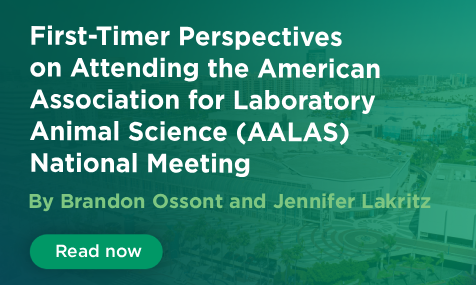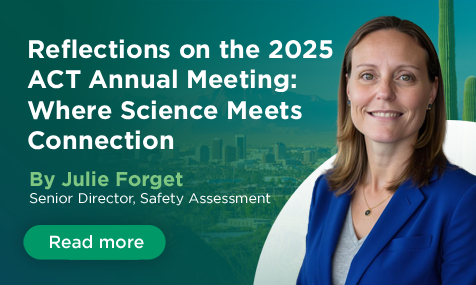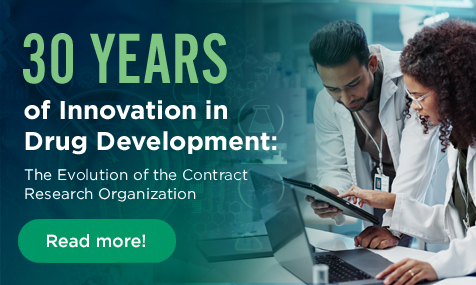Five Promising Treatment Areas in Early-Phase Drug Development in 2024
Early-phase drug development is an ever-changing landscape, as emerging science leads to new promising areas of research for the treatment of human health issues. In this blog article, we review some of these areas of investigation where Altasciences has robust expertise and solution offerings.
1. Psychedelics
Psychedelic therapy (or psychedelic-assisted therapy) refers to the use of psychedelic drugs, such as psilocybin, MDMA, LSD, ketamine, and ayahuasca, to treat mental disorders, especially those that have no effective treatments available or are treatment resistant. According to a 2022 article published in Molecular Psychiatry, treatment resistance affects 20 to 60% of patients with psychiatric disorders.
Exactly how psychedelics work to treat mental health disorders is still being explored, and current data supports the benefit of pairing psychedelics with proven therapies for people with diagnoses of depression, anxiety, PTSD, and substance use disorders related to smoking, alcohol, and drugs.
LSD and psilocybin are serotonergic, delivering a strong neuroplasticity-inducing effect. Under the effect of psychedelics, neurons forming new connections are primed to grow and existing connections can change, which causes individuals to have insights, realizations, and changes in their thinking. The theory is that if the brain settles into this state, some of the circuitry responsible for depression or anxiety may be altered and reform around a new perspective.
Ketamine is a dissociative anesthetic approved in 2019 by the U.S. Food and Drug Administration (FDA) as a nasal spray called esketamine, for treatment-resistant depression. Its use in the treatment of substance use disorders is still under study.
With industry-leading solutions in the field of psychedelic drug development, and CNS drugs in general, our CNS Center of Excellence has supported numerous CNS drug development programs and is on the leading edge of the latest scientific knowledge in the field.
Psychedelic Drug Development resources
Watch our on-demand webinar, “Square Peg in a Round Hole: Navigating the Unique Attributes of Psychedelic Drug Development”.
Read The Altascientist, “Considerations for Psychedelic Drug Development”.
2. Gene Therapy
Gene therapy is currently considered for diseases, often rare, that have no other cures.
It is a growing field where new technology, and an increasing understanding of the science, are bringing advancements in drug development.
Researchers utilize several approaches to gene therapy, including:
- replacing a mutated gene that causes disease with a healthy copy of the gene;
- inactivating, or “knocking out,” a mutated gene that is functioning improperly; and
- introducing a new gene into the body to help fight a disease using a vector.
Different vectors and their potential impact beyond the delivery of the gene into the host are being investigated. Several viral vectors are being used currently, in addition to non-viral vectors, such as oligonucleotides, naked DNA, and lipoplexes and polyplexes. Technologies for somatic gene modification (replacing or inactivating defective genes) are advancing in sophistication and applicability, with CRISPR being the most recent.
The FDA approved the first gene therapy in 2017 for certain pediatric and young adult patients with a form of acute lymphoblastic leukemia (ALL), and as of December 2023, there are over 30 approved cell and gene therapies on the market in the U.S.A.
Our preclinical and bioanalytical experts have extensive experience in leading-edge technologies to support sponsors in the advancement of their gene therapy products. We have conducted over 130 in-life studies in the last five years (over 95% conducted in NHPs), including IND-enabling studies for rare diseases and CRISPR gene editing therapeutics in NHPs.
Gene Therapy resources
Watch our on-demand webinar, “Nonclinical Safety Assessment for Gene Therapy Products”.
Read The Altascientist, “Nonclinical Studies in Cell and Gene Therapy”.
3. Oligonucleotide-Based Techniques
Most oligonucleotide therapies act through antisense mechanisms and are directed against various RNA species. They work by binding to specific sequences of nucleotides present within the mRNA structure and can induce mechanisms that either decrease, restore, or modify protein expression. And since proteins are often linked to disease, there's huge potential to treat a broad range of diseases with this technology.
An important property of mRNAs is that the precise code they contain is specific to each protein. Therefore, antisense oligonucleotides (ASOs) can be designed to target the production of protein from a single gene out of the many thousands in the human genome. If the gene being targeted is mutated, just the mutant form of the gene can be impacted.
Since the FDA approved the first oligonucleotide drug for clinical use in 1998, to treat cytomegalovirus retinitis (CMV) in immunocompromised patients, the therapeutic landscape has undergone significant change. ASOs are of special interest for approximately 8,000 rare disorders, where rare is defined as a disease that affects less than 1 in 2,000 people in Europe, or less than 1 in 200,000 people in the U.S.A.
According to a review article published in Nature.com, as of January 2024, ASO therapeutics have successfully been utilized to great genetic disorders like spinal muscular atrophy (SMA), homozygous familial hypercholesterolemia, and primary hyperoxaluria type 1. Fifteen oligonucleotides have so far received market authorization in different countries, and several others are being test in clinical Phase I to III trials.
Several bioanalytical strategies for the quantitation of ASOs are available at Altasciences. We have expertise in both ligand binding and hybrid LC-MS methodologies. Our experts align the appropriate bioanalytical approach with the goals of the oligonucleotide drug development program, based on its size/type, the sensitivity and specificity required, as well as throughput needed based on the preclinical or clinical phase of the drug in development. We have significant expertise in analyzing pharmacokinetic, pharmacodynamic, and anti-drug antibody endpoints from the preclinical phase to clinical trials.
ASO Resources
Read this case study about resolving issues with matrix effect in ASO detection
Read The Altascientist, “Antisense Oligonucleotides”
4. Antibody Drug Conjugates (ADCs)
Antibody-drug conjugates (ADCs) represent a growing treatment modality for cancer therapy, enabling the delivery of a potent cytotoxic agent targeted to tumor cells (unlike traditional chemotherapy that is administered systemically and affects non-target healthy tissues and organs).
ADCs are rapidly becoming the standard of care in solid tumor breast cancer, across traditional human epidermal growth factor receptor 2 (HER2)+, hormone receptor+ (HR+), and triple-negative disease subtypes. Modifying the payload to use immune-stimulating agents or combination therapies with immunotherapy and other effective targeted therapies may further extend the utility of these agents in the treatment of solid tumors.
Future generations of therapeutic agents that build on the success of ADCs include immune-stimulating antibody conjugates, engineered toxin bodies, and radioligand conjugates that aim to improve the therapeutic index while minimizing toxicity.
According to an article published in Frontiers in Pharmacology, as of October 2023, there were 15 FDA-approved ADCs on the market, and more than one hundred in clinical development in the U.S.A., Asia, and Europe.
Altasciences’ bioanalytical capabilities include leading-edge technologies for testing ADCs to meet the requirement of your project. We have expertise with ligand binding approaches, to measure total antibodies and ADCs with sensitive and high-throughput assays. Our hybrid LBA/LC-MS workflow provides a multiplexed, single analytical platform that provides a larger dynamic range and quantifies metabolites and linker-payloads, by including quantitation of free payloads together with total antibody and ADCs.
Consult a Q&A with our resident expert, Dr. Danielle Salha, Senior Director, Immunology and Immunochemistry, Ligand Binding Assays.
5. Glucagon-Like Peptide-1 (GLP-1) Receptor Agonists (GLP-1RA)
The field of GLP-1-based medicines is bringing hope of improved health for many people living with difficult to treat, chronic cardiometabolic and neurodegenerative disorders that significantly impact both quality of life and healthcare burden. Advancements in GLP-1 science are delivering treatment options for chronic cardiometabolic disorders, and research into potential treatments for neurodegenerative disorders.
The first GLP-1RA for the treatment of Type 2 Diabetes (T2D) was approved in 2005, supported by data that showed GLP-1 stimulated insulin secretion. Subsequently, data showing that GLP-1 reduced appetite and food intake supported the first approval of a GLP-1RA for obesity and weight loss. In 2022, a GIP-GLP-1R coagonist, tirzepatide, used to treat people with T2D, was found to produce significant weight loss and was also approved for treatment of obesity.
As of 2024, there are numerous once-weekly GLP-1RA injections used to treat type 2 diabetes—Liraglutide and semaglutide are approved for treatment of obesity, and oral semaglutide is available as a once-daily option. GLP-1RAs have also shown efficacy in heart failure with preserved ejection fraction (HFpEF), although there is currently no approved indication for this use. GLP-1RAs have also been found to have neuroprotective effects and are being studied in people with Parkinson’s and Alzheimer’s diseases.
Several small molecule GLP-1R agonists, such as oral orforglipron, are in late-stage clinical development. Newer GLP-1RAs and GLP-1–based coagonists are being studied in separate trials for Type 2 Diabetes, diabetic kidney disease, peripheral artery disease, and metabolic liver disease.
GLP-1 and GLP-1RA Resources
Read an article published in the Lancet on a cagrilintide with semaglutide study conducted at Altasciences.
Read The Altascientist, “The Global Challenge of Metabolic Disorders”
Looking Ahead
The ever-evolving landscape of drug discovery and early-phase development is brimming with new methods and advancements in technology. As with any novel approach in the field of human health intervention, new discoveries lie ahead, and drug development experts at Altasciences are evolving with the science, applying learnings, and adapting as we progress along the path from discovery to treatment.
If you have molecules in early-phase development, contact the experts at Altasciences today to see how we can support your program.



